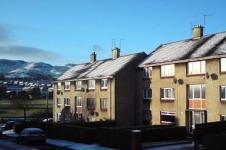Part L will soon include heat loss through party cavity walls and new homes will need to be sealed properly
For the first time heat losses through party cavity walls will be accounted for in Part L of the ��ɫ����TV Regulations.
The consultation on SAP 2009, the Part L compliance calculation tool for homes, includes figures for heat losses from party cavity walls and is one of the most significant step changes in improving energy efficiency.
A dwelling can lose between 12% and 24% of its heat from the cavity wall dependent on the party wall location, construction and house type. To put this in perspective including party walls in this revision of Part L could cut carbon emissions from housing built between 2010 and 2050 by 2% to 3% which is equivalent to 50% of current emissions from air travel.
Annually over 75% of new homes feature party walls with a cavity and will need to meet both sound and thermal compliance factors, which have previously clashed in terms of material specifications.
Including heat losses from party cavity walls will make a huge difference to the energy envelope calculations for new homes as the SAP 2009 proposal assumes cavity walls has a very poor thermal performance equating to a U value of 0.5Wm2K.
This will force the industry to either move towards solid walls or seal the cavity to stop heat loss. The reason why heat is lost through party walls is down to the movement of air within the party wall cavity which escapes from the cavity at the top of the building and at external wall junctions.
Appropriate sealing of the cavity from the external wall cavity and sealing at the wall head prevents heat loss at these junctions. Infilling with insulation quilt or batt materials only work if the cavity is well sealed, as the slightest gaps can still allow a ‘chimney effect’ and heat loss to occur. Traditional cavity socks have not been able to address this heat loss mechanism as these can be easily punctured and are often incorrectly fitted.
Small step changes can collectively make very positive contributions in addressing some of the future energy issues and emissions. The new build housing industry can play a leading role. It is with regret that the thermal upgrading and cavity fill of the UK’s existing housing has not been tackling cavity party walls. Existing housing has a crucial role in addressing future emission targets and energy usage factors. This is not the future of others but the future of our own and our future making.
WallCap 400
Edinburgh Napier University devloped the WallCap 400 solution in 2008. It aims to reduce party wall heat loss and improve air tightness. The product seals the party wall both horizontally and vertically wall and prevents air movement and convected heat loss. WallCap 400 is situated at the wall head at the underside of the roof or floor junction.
Postscript
Professor Sean Smith is professor of Construction Innovation at the ��ɫ����TV Performance Centre, Edinburgh Napier University.



























